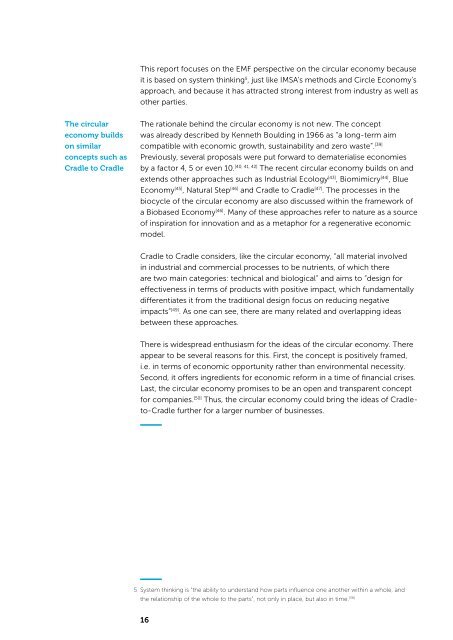Unleashing the Power of the Circular Economy
Unleashing the Power of the Circular Economy
Unleashing the Power of the Circular Economy
Create successful ePaper yourself
Turn your PDF publications into a flip-book with our unique Google optimized e-Paper software.
The circular<br />
economy builds<br />
on similar<br />
concepts such as<br />
Cradle to Cradle<br />
This report focuses on <strong>the</strong> EMF perspective on <strong>the</strong> circular economy because<br />
it is based on system thinking 5 , just like IMSA’s methods and Circle <strong>Economy</strong>’s<br />
approach, and because it has attracted strong interest from industry as well as<br />
o<strong>the</strong>r parties.<br />
The rationale behind <strong>the</strong> circular economy is not new. The concept<br />
was already described by Kenneth Boulding in 1966 as “a long-term aim<br />
compatible with economic growth, sustainability and zero waste”. [39]<br />
Previously, several proposals were put forward to dematerialise economies<br />
by a factor 4, 5 or even 10. [40, 41, 42] The recent circular economy builds on and<br />
extends o<strong>the</strong>r approaches such as Industrial Ecology [43] , Biomimicry [44] , Blue<br />
<strong>Economy</strong> [45] , Natural Step [46] and Cradle to Cradle [47] . The processes in <strong>the</strong><br />
biocycle <strong>of</strong> <strong>the</strong> circular economy are also discussed within <strong>the</strong> framework <strong>of</strong><br />
a Biobased <strong>Economy</strong> [46] . Many <strong>of</strong> <strong>the</strong>se approaches refer to nature as a source<br />
<strong>of</strong> inspiration for innovation and as a metaphor for a regenerative economic<br />
model.<br />
Cradle to Cradle considers, like <strong>the</strong> circular economy, “all material involved<br />
in industrial and commercial processes to be nutrients, <strong>of</strong> which <strong>the</strong>re<br />
are two main categories: technical and biological” and aims to “design for<br />
effectiveness in terms <strong>of</strong> products with positive impact, which fundamentally<br />
differentiates it from <strong>the</strong> traditional design focus on reducing negative<br />
impacts” [49] . As one can see, <strong>the</strong>re are many related and overlapping ideas<br />
between <strong>the</strong>se approaches.<br />
There is widespread enthusiasm for <strong>the</strong> ideas <strong>of</strong> <strong>the</strong> circular economy. There<br />
appear to be several reasons for this. First, <strong>the</strong> concept is positively framed,<br />
i.e. in terms <strong>of</strong> economic opportunity ra<strong>the</strong>r than environmental necessity.<br />
Second, it <strong>of</strong>fers ingredients for economic reform in a time <strong>of</strong> financial crises.<br />
Last, <strong>the</strong> circular economy promises to be an open and transparent concept<br />
for companies. [50] Thus, <strong>the</strong> circular economy could bring <strong>the</strong> ideas <strong>of</strong> Cradleto-Cradle<br />
fur<strong>the</strong>r for a larger number <strong>of</strong> businesses.<br />
5 System thinking is “<strong>the</strong> ability to understand how parts influence one ano<strong>the</strong>r within a whole, and<br />
<strong>the</strong> relationship <strong>of</strong> <strong>the</strong> whole to <strong>the</strong> parts”, not only in place, but also in time. [38]<br />
16



